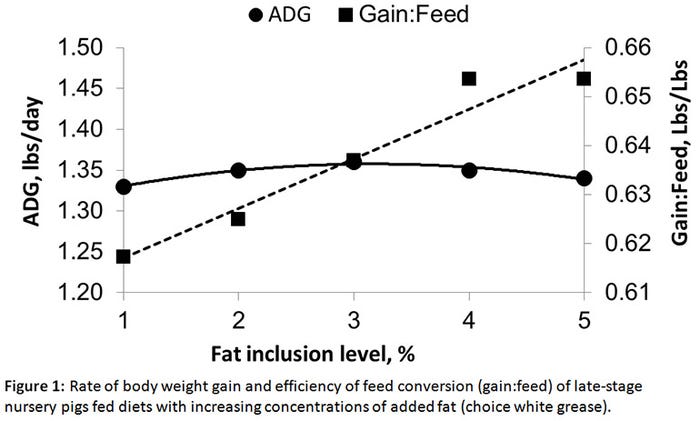Does it pay to feed oils or fats to nursery pigs?
The economic value of supplemental lipids should be determined in production facilities to make informed decisions regarding their use in diets of pigs at various stages of production.
April 13, 2017

By Eric van Heugten, North Carolina State University; R. Dean Boyd, Cate Zier-Rush, and David Rosero, Hanor Co.
In a previous column, we demonstrated the importance of a comprehensive quality control program for lipid sources (oils and fats) used in nursery pig diets. We showed, in a commercial facility, that peroxidized lipids increased mortality, number of pigs medicated and number of pigs that were excessively light, resulting in a reduced number of pigs and a lower total pig weight by the end of the nursery. This has obvious negative financial consequences.
Once good quality lipid sources have been identified, the impact of supplemental lipids on pig growth performance and economic return needs to be investigated in all phases of production. The value of lipids in diets for pigs depends on the productive energy content assigned to the lipids, their impact on growth performance and their cost. The response to lipids is especially important, because we need to know the price threshold (expressed as the lipid to corn price ratio) for added lipids so that the most economic gain can be achieved.
We conducted a study in a commercial nursery using 2,156 pigs to determine the economic value of supplemental lipid, involving a step-wise increase of added lipids to the diets of pigs in the body weight period of 27.5 to 62.5 pounds. The lipid source used was choice white grease and was supplemented at 1, 2, 3, 4 and 5% of the basal diet comprised of corn, soybean meal and distiller dried grains with solubles. The standardized ileal digestible lysine to calorie ratio was maintained constant across diets. Average daily feed intake linearly decreased (P = 0.024) and gain:feed linearly increased (P < 0.001) with increasing lipid supplementation (Figure 1).

Average daily gain appeared to improve in a quadratic manner, but this was not statistically significant. It is possible that the reduction in feed intake with increasing lipid supplementation resulted in insufficient nutrient intake, especially at the higher levels of added lipids. Although amino acid composition was adjusted relative to energy (by keeping the ileal digestible amino acid to calorie ratio constant across diets), this was not the case with calcium, phosphorus, micro-minerals and vitamins, and this may be important to maximize the potential effects of added lipids on ADG.
This study clearly showed that lipid supplementation improved gain:feed, primarily by reducing feed intake and suggested that it may be important to maintain nutrient-to-calorie ratios (beyond amino acids) to maximize the response. The financial value of lipid addition was calculated using only gain:feed because total gain (and the financial value created as gain) did not significantly improve for any level of added lipid. The financial evaluation considers the economic value of the lipid relative to corn (lipid:corn price ratio), ranging from 2.5 to 3.5. Corn is the principle energy supplying ingredient in swine diets and the price relationship of lipid-to-corn is practically relevant. The net effect of adding lipids beyond 1% was to increase feed cost of gain at any lipid price shown (Figure 2).

Thus, supplemental lipids appeared to be helpful to improve performance, but were not beneficial economically during the nursery phase until the lipid:corn price ratio was 2.5 or less. The rate of gain:feed improvement with lipid addition was not as large as typically observed with growing-finishing pigs. In finishing pigs, lipid supplementation becomes economically attractive at a lipid:corn price ratio of 3.0. That difference between the value of fat between nursery pigs and finishing pigs is even greater under hot conditions during the summer, when reaching market weight within an acceptable time-frame to turn the barns is a realistic challenge. In that case, a lipid:corn price ratio of 5 to 6 in finishing pigs can often be justified. Supplemental lipids have a lower economic value in late-nursery diets compared to finishing diets because of their limited impact on daily gain and moderate impact on feed efficiency.
We conclude that the economic value of supplemental lipids should be determined in production facilities to make informed decisions regarding their use in diets of pigs at various stages of production.
You May Also Like



